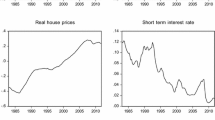Abstract
The instability of standard money demand functions has undermined the role of monetary aggregates for monetary policy analysis in the euro area. This paper uses country-specific monetary aggregates to shed more light on the economics behind the instability of euro area money demand. Our results obtained from panel estimation indicate that the observed instability of standard money demand functions could be explained by omitted variables like e.g. technological progress that are important for money demand but constant across member countries.




Similar content being viewed by others
Notes
Beyer et al. (2001) discuss the alternative ways to construct synthetic euro area data.
If a European household invests money abroad, it will mainly be for portfolio reasons. On average cross-border holdings from other EMU members account for only 8% of deposits of non-monetary financial institutions, see ECB bank balance sheet statistics. Note that 8% is a stock and not a flow value such that flows could still be important within one period. Unfortunately, however, the availability of flow data on cross-country business is very limited. Cross-border holdings usually tend to be higher in smaller countries. Thus, cross-border holdings are more important in the US partly because the cross-sectional units (the states) are relatively small.
The time-series literature addresses the endogeneity issue by estimating VARs and testing for weak exogeneity, see e.g. Hayo (1999).
The only exception is Luxembourg which is not included because of data availability.
Currency accounts on average for 6.7% of M3 over the whole sample horizon.
Greece joined the euro in 2001, Slovenia, Cyprus, Malta and Slovakia followed.
In Mulligan and Sala-i-Martin (1992) the price indices cancel out when demeaning the data. Therefore they basically estimate a nominal demand function.
Blaes (2009) analyses the dynamics after changes in the monetary policy in more detail.
Note that these indexes are only available from 2000 onwards. Not all of these indexes are constructed in the same way but this is the best we can do because there is no EU-harmonised index, yet.
We also checked the robustness of our results with respect to country-specific effects of house prices. Allowing different effects for countries with weak and strong growth in house prices shows, however, that house prices are insignificant for both groups of countries. For brevity, results are not presented but are available on request.
References
Arnold I (1994) The myth of a stable European money demand. Open Econ Rev 5:249–259
Beyer A (2009) A stable model for euro area money demand revisiting the role of wealth. ECB Working Paper No. 1111
Beyer A, Doornik J, Hendry D (2001) Constructing historical euro-zone data. Econ J 3:102–121
Blaes B (2009) Money and monetary policy transmission in the euro area: evidence from FAVAR- and VAR approaches. Deutsche Bundesbank Discussion Paper, Series 1: Economic Studies (18)
Boone L, van den Noord P (2008) Wealth effects on money demand in the euro area. Empir Econ 34:525–536
Brand C, Cassola N (2004) A money demand system for euro area M3. Appl Econ 36(8):817–838
Cappiello L, Kadareja A, Sorensen C, Protopapa M (2010) Do bank loans and credit standards have an effect on output? a panel approach for the euro area. ECB Working Paper No. 1150
Carstensen K (2006) Stock market downswing and the stability of European Monetary Union money demand. J Bus Econ Stat 24(4):395–402
Coenen G, Vega J-L (2001) The demand for M3 in the euro area. J Appl Econom 16:727–748
de Bondt G (2009) Euro area money demand—empirical evidence on the role of equity and labour markets. ECB Working Paper No. 1086
Dreger C, Wolters J (2009) Money velocity and asset prices in the euro area. Empirica 36(1):51–63
Dreger C, Wolters J (2010) Investigating M3 money demand in the euro area. J Int Money Finance 29(1):111–122
Driscoll J (2004) Does bank lending affect output? Evidence from the U.S. states. J Monet Econ 51:451–471
ECB (2003) The outcome of the ECB’s evaluation of its monetary policy strategy. Monthly Bulletin, 79–92
ECB (2008) Financial integration in Europe, chapter 1
Funke M (2001) Money demand in Euroland. J Int Money Finance 20:701–713
Gerlach S, Svensson L (2003) Money and inflation in the euro area: A case for monetary indicators? J Monet Econ 50(8):1649–1672
Greiber C, Lemke W (2005) Money demand and macroeconomic uncertainty. Deutsche Bundesbank Discussion Paper 26(5)
Hayo B (1999) Estimating a European demand for money. Scott J Polit Econ 46(3):221–244
Lütkepohl H, Teräsvirta T, Wolters J (1998) Modeling the demand for M3 in the unified Germany. Rev Econ Stat 80(3):399–409
Mankiw G (1992) Comment on: Mulligan CB and Sala-i-Martin X (1992) U.S. money demand: surprising cross-sectional estimates. Brookings Pap Econ Act 2:285–327
Mulligan C, Sala-i Martin X (1992) U.S. money demand: surprising cross-sectional estimates. Brookings Pap Econ Act 2:285–327
Pesaran M (2007) A simple panel unit root test in the presence of cross-sectional dependence. J Appl Econom 22:265–312
Pesaran M, Shin Y (1999) An autoregressive distributed lag modelling approach to cointegration analysis. In: Strom S (eds) Econometrics and economic theory in the 20th century: The Ragnar Frisch centennial symposium. Cambridge University Press, Cambridge
Pesaran M, Shin Y, Smith R (1999) Pooled mean group estimation of dynamic heterogenous panels. J Am Stat Assoc 94(446):621–634
Rondorf U (2010) Are bank loans important for output growth: a panel analysis of the euro area. Working paper, Freie Universität Berlin
Setzer R, Wolff G (2009) Money demand in the euro area: new insights from disaggregated data. EU Commission, Economic Papers (373)
Westerlund J (2005) New simple test for panel cointegration. Econom Rev 24(3):297–316
Acknowledgments
We thank Jörg Breitung, Christian Offermanns and two anonymous referees for helpful comments and suggestions. This research was supported by the Deutsche Forschungsgemeinschaft through the CRC 649 “Economic Risk”.
Author information
Authors and Affiliations
Corresponding author
Rights and permissions
About this article
Cite this article
Nautz, D., Rondorf, U. The (in)stability of money demand in the euro area: lessons from a cross-country analysis. Empirica 38, 539–553 (2011). https://doi.org/10.1007/s10663-010-9139-y
Received:
Accepted:
Published:
Issue Date:
DOI: https://doi.org/10.1007/s10663-010-9139-y




